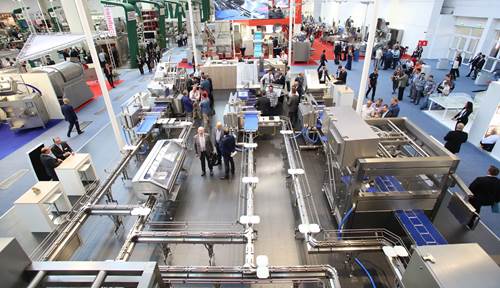IFFA 2019 - optimized production through digitization

From May 4th to 9th, leading international companies will show their latest technologies at IFFA and provide information on the most important trends and developments in the meat processing industry. The optimization of production processes takes up a lot of space. The best practice examples shown at the fair offer trade visitors valuable suggestions and decision-making aids.
Smart sensors - the sense of the machines
In the smart factory, products and decentralized machines are supposed to communicate with each other, organize, manage and control themselves. A basic requirement for this is the constant availability of the status data of products, machines, drives, bearings, etc. This task is carried out by so-called smart sensors. In addition to the actual sensor for recording measured variables, they also have integrated microprocessors for processing and processing signals. In addition to classic measured variables such as temperature, power consumption, torque and pressure, they also record gases and microbial contamination.

Source: Messe Frankfurt Exhibition GmbH / Jochen Günther
Paradigm shift in "condition monitoring"
Classic maintenance at fixed intervals or operating hours is usually carried out too early for safety reasons and thus unnecessarily shortens the running times of components that are still intact, such as drives, shafts or bearings. As a result, companies lose capital and valuable resources. Machine damage doesn't happen out of the blue. They announce themselves long in advance by unusual noises, sudden machine vibrations or temperature increases as well as increased power consumption and the like. These changes can be recorded in real time using intelligent sensors, monitored online and evaluated with the appropriate CMS (Condition Monitoring Software). This enables targeted maintenance and provides valuable information for further optimizing machines and systems.
RFID chips are convincing as electronic job tickets
RFID (Radio Frequency Identification) enables the real-time transmission of data by radio between transponders and read / write heads. The transponders integrated in slaughterhooks, saddles, pallets, packaging or machine parts communicate bidirectionally with the read / write heads installed at the processing or packaging stations. For example, the RFID chips integrated in the slicer knife ex works contain not only the geometry data of the cutting edges but also the associated sharpening programs and their encrypted article and serial numbers. The RFID read / write head installed in the sharpening module reads in the knife data, identifies the knife, executes the associated sharpening program and then updates the transponder data including details of the remaining processing reserves. The principle can also be transferred to many other processing stages along the value chain.
Vision systems ensure efficiency, transparency and quality
The combination of digital camera and image evaluation software gives machines the ability to see and thus the ability to specifically react to changes in their environment and to make decisions. This enables them to recognize the location, position, orientation, shape, size and color of any objects on conveyor belts. The data obtained in this way are suitable, for example, for controlling robots and discharge units or for assessing fat and lean portions when classifying bacon slices inline as A, B or C goods. Further applications are checking for completeness and intactness of packaging as well as the correct placement and printing of accompanying or shipping labels.
Plan more effectively with the digital twin
The digital twin is more than just a digital 1: 1 copy of its physical counterpart. It has the same sensors, behavior, properties and software, even if only virtually, and is also networked with other systems. And that makes it the ideal development tool for system planners and designers.
Typical areas of application are virtual simulations of processes as well as functional tests of components, assemblies, machines or entire systems including their control and application software. This enables errors to be detected and corrected in advance of the actual production, which saves costs, time, resources and energy. Experts from sales, planning, production and maintenance on both the manufacturer and customer side can use the digital twin to work through, discuss and optimize all options realistically. Further options of the digital twin are the training of future machine and system operators in handling the system as well as virtual commissioning. And ultimately, the real system can also be operated and maintained in real terms via its digital twin - and that across national borders.
The IFFA will open its doors in Frankfurt am Main from May 4th to 9th, 2019. The leading international trade fair for the meat industry is starting on a positive note: more than 1.000 exhibitors from around 50 countries have already registered for the industry highlight. They occupy a gross exhibition area of 120.000 square meters - eight percent more than at the previous event. The integration of the new exhibition hall 12 enables IFFA to grow. In addition, the fair is concentrated for the first time in the western part of the Frankfurt exhibition center and thus offers a comprehensive overview and a future-oriented exhibition experience.
All information and tickets at: www.iffa.com
